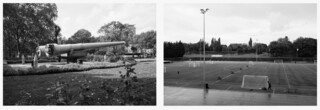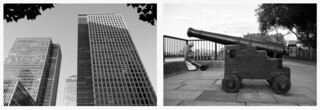The guns are aimed at everything: primary schools, restaurants, blocks of flats, offices, houses, groups of trees, playing fields, public artworks, the railway network, the river. Anything, really: less aiming than pointing wildly in all directions, a city-wide stick-up. They’re mostly antique British cannons: the reliable naval 12-pounders that were ubiquitous on 18th-century ships of the line, the heavy 18-pounders that bossed the empire’s field artillery into the early 1900s. A few foreign pieces have found their way into the arsenal too: an ornate 52-pound 16th-century Turkish cannon is poised to let fly at a public toilet and a beefy French mortar stands ready to bombard the Royal Albert Hall. There are also a handful of more modern weapons in play: the main gun of a Chieftain tank is raised towards a Kensington mansion block, while a Soviet T34 has a slab of flats on the Old Kent Road in its sights. A mid-20th-century anti-aircraft gun scans the empty skies above Newham. The colossal naval guns outside the Imperial War Museum last saw service in the Second World War; now they target a sports centre in Haringey. It is an impressive display of firepower, all aimed squarely at civilian targets.
These are London’s monumental guns, as documented by the artist Sean Dower in Monumental Guns and Their Targets (Everyday Press, £12). It’s a brilliantly simple and powerful work: Dower has placed a photograph of every publicly emplaced gun in London next to photographs of what they would hit if fired (Dower hasn’t included guns with their muzzles buried, such as those repurposed as bollards). The ballistic calculations are as precise as possible, based on the angle of elevation and the known or inferred ammunition, charge and range of each weapon. Most of the guns are clustered around the Thames in Central London and the East End, drawn towards the water in dull remembrance of shipboard service or silently haunting their natal home in the Royal Arsenal like cast-iron spectres. They typically look to fire away from or over the river, recalling the glory days of war and conquest as they cannonade the homes of Greenwich and the schools of Newham, shell the recalcitrant Corbynites of Islington and rain death on gentrifying Southwark.
Although some act as markers for particular spots – guardrooms, arsenals etc – together the guns commemorate British military power over the centuries, whether in defence of the realm, on the high seas or at war in foreign parts. Almost all of them are ‘age of sail’ weapons from Britain’s brutal and belligerent centuries of imperial expansion: naval cannons from the era of the slave trade and field artillery from the high days of empire. Bad statuary in the likeness of bad men is one thing, but these cannons are real. Violence always comes home in the end: the guns point at Londoners now, a silent reminder that the full force of the state can be turned on its citizens, should they become too restless. (During the Troubles, my father warned me that the techniques of violence and crowd control the police used in Northern Ireland would eventually be used here on striking workers, protesters or students.)
Dower’s ordnance survey shows a more chaotic energy at work, too, as Britain’s past comes loose on the deck of the present. The guns are a crude display of historic state power, but the randomness of their new targets turns them into symbols of a state operating without a coherent object. And so, positioned higgledy-piggledy in London streets, a battery of defunct cannons threatens to destroy ordinary people’s homes and livelihoods, day-to-day infrastructure and basic amenities, art and nature, new things and old things. You would be hard pressed to find a better metaphor for the current political regime and the national climate it has produced.
Send Letters To:
The Editor
London Review of Books,
28 Little Russell Street
London, WC1A 2HN
letters@lrb.co.uk
Please include name, address, and a telephone number.



